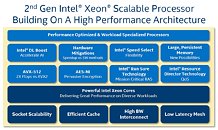- Joined
- Oct 9, 2007
- Messages
- 47,294 (7.53/day)
- Location
- Hyderabad, India
| System Name | RBMK-1000 |
|---|---|
| Processor | AMD Ryzen 7 5700G |
| Motherboard | ASUS ROG Strix B450-E Gaming |
| Cooling | DeepCool Gammax L240 V2 |
| Memory | 2x 8GB G.Skill Sniper X |
| Video Card(s) | Palit GeForce RTX 2080 SUPER GameRock |
| Storage | Western Digital Black NVMe 512GB |
| Display(s) | BenQ 1440p 60 Hz 27-inch |
| Case | Corsair Carbide 100R |
| Audio Device(s) | ASUS SupremeFX S1220A |
| Power Supply | Cooler Master MWE Gold 650W |
| Mouse | ASUS ROG Strix Impact |
| Keyboard | Gamdias Hermes E2 |
| Software | Windows 11 Pro |
Intel late Tuesday made a boat-load of enterprise-relevant product announcements, including the all important update to its Xeon Scalable enterprise processor product-stack, with the addition of the new 56-core Xeon Scalable "Cascade Lake" processor. This chip is believed to be Intel's first response to the upcoming AMD 7 nm EPYC "Rome" processor with 64 cores and a monolithic memory interface. The 56-core "Cascade Lake" is a multi-chip module (MCM) of two 28-core dies, each with a 6-channel DDR4 memory interface, totaling 12-channel for the package. Each of the two 28-core dies are built on the existing 14 nm++ silicon fabrication process, and the IPC of each of the 56 cores are largely unchanged since "Skylake." Intel however, has added several HPC and AI-relevant instruction-sets.
To begin with, Intel introduced DL Boost, which could be a fixed-function hardware matrix multiplier that accelerates building and training of AI deep-learning neural networks. Next up, are hardware mitigation against several speculative execution CPU security vulnerabilities that haunted the computing world since early-2018, including certain variants of "Spectre" and "Meltdown." A hardware fix presents lesser performance impact compared to a software fix in the form of a firmware patch. Intel has added support for Optane Persistent Memory, which is the company's grand vision for what succeeds volatile primary memory such as DRAM. Currently slower than DRAM but faster than SSDs, Optane Persistent Memory is non-volatile, and its contents can be made to survive power-outages. This allows sysadmins to power-down entire servers to scale down with workloads, without worrying about long wait times to restore uptime when waking up those servers. Among the CPU instruction-sets added include AVX-512 and AES-NI.




Intel Speed Select is a fresh-spin on a neglected feature most processors have had for decades, allowing administrators to select specific multipliers for CPU cores on the fly, remotely. Not too different from this is Resource Director Technology, which gives you more fine-grained QoS (quality of service) options for specific cores, PIDs, virtual machines, and so on.
Unlike previous models of Xeon Scalable, the first Xeon Scalable "Cascade Lake" processor, the Xeon Platinum 9200, is an FC-BGA package and not socketed. This 5,903-pin BGA package uses a common integrated heatspreader with the two 28-core dies underneath. The two dies talk to each other over a UPI x20 interconnect link on-package, while each die puts out its second UPI x20 link as the package's two x20 links, to scale up to two packages on a single board (112 cores).
View at TechPowerUp Main Site
To begin with, Intel introduced DL Boost, which could be a fixed-function hardware matrix multiplier that accelerates building and training of AI deep-learning neural networks. Next up, are hardware mitigation against several speculative execution CPU security vulnerabilities that haunted the computing world since early-2018, including certain variants of "Spectre" and "Meltdown." A hardware fix presents lesser performance impact compared to a software fix in the form of a firmware patch. Intel has added support for Optane Persistent Memory, which is the company's grand vision for what succeeds volatile primary memory such as DRAM. Currently slower than DRAM but faster than SSDs, Optane Persistent Memory is non-volatile, and its contents can be made to survive power-outages. This allows sysadmins to power-down entire servers to scale down with workloads, without worrying about long wait times to restore uptime when waking up those servers. Among the CPU instruction-sets added include AVX-512 and AES-NI.




Intel Speed Select is a fresh-spin on a neglected feature most processors have had for decades, allowing administrators to select specific multipliers for CPU cores on the fly, remotely. Not too different from this is Resource Director Technology, which gives you more fine-grained QoS (quality of service) options for specific cores, PIDs, virtual machines, and so on.
Unlike previous models of Xeon Scalable, the first Xeon Scalable "Cascade Lake" processor, the Xeon Platinum 9200, is an FC-BGA package and not socketed. This 5,903-pin BGA package uses a common integrated heatspreader with the two 28-core dies underneath. The two dies talk to each other over a UPI x20 interconnect link on-package, while each die puts out its second UPI x20 link as the package's two x20 links, to scale up to two packages on a single board (112 cores).
View at TechPowerUp Main Site







 and still on 14 nm. I am afraid to think op tdp on this thing or how low core clock needs to be to hold with in a tdp that dosent need water cooling.
and still on 14 nm. I am afraid to think op tdp on this thing or how low core clock needs to be to hold with in a tdp that dosent need water cooling.